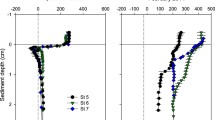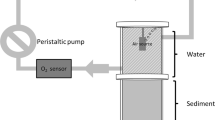Abstract
To reveal the mechanisms of sedimental H2S accumulation, annual investigations on sedimental environments were conducted in two temperate estuarine lagoons. The lagoons, Gamo and Idoura (Japan), have similar shapes, locations, and topographical properties but different degrees of H2S accumulation. Water stagnation causes a high phytoplankton biomass (Chl. a; 26–52 μg l−1) in the inner Gamo Lagoon. Gamo Lagoon sediment was characterized by high bounded sulfides (bounded S
mainly FeS) and H2S contents, and low C/N ratios (mean = 10.4) and iron (reactive Fe2+ and total Fe) contents. H2S was not detected in Idoura Lagoon where phytoplankton biomass was much lower (Chl. a; 0.6–4 μg l−1). Idoura Lagoon sediment had high C/N ratios (mean=17.9) and high iron contents. The C/N ratio difference implies that organic matter in Gamo Lagoon originates mainly from more decomposable phytoplankton, while organic matter in Idoura Lagoon derives mainly from terrestrial vascular plants with lower decomposability. The excess loading of phytoplanktonic detritus in Gamo accelerates sedimentary microbial activity, including sulfate reduction (i.e., H2S production). High Fe2+and low bounded S contents in Idoura sediment indicate a high chemical buffering capacity toward H2S. In contrast, almost all Fe2+ in Gamo Lagoon had already reacted with H2S as FeS. H2S accumulation in Gamo Lagoon is caused by low sedimentary chemical buffering capacity toward H2S, as well as higher microbial H2S production, caused by the excess loading of phytoplanktonic detritus.
Similar content being viewed by others
References
Canfield, D. E., 1989. Reactive iron in marine sediments. Geochimica et Cosmochimica Acta 53: 619-632.
Capone, D. G. & R. P. Kiene, 1988. Comparison of microbial dynamics in marine and freshwater sediments. Limnology and Oceanography 33: 725-749.
Diaz, R. J. & R. Rosenberg, 1995. Marine benthic hypoxia: a review of its ecological effects and the behavioural responses of benthic macrofauna. Oceanography and Marine Biology: An Annual Review 33: 245-303.
Giordani, G., M. Bartoli, M. Cattadori & P. Viaroli, 1996. Sulphide release from anoxic sediments in relation to iron availability and organic matter recalcitrance and its effects on inorganic phosphorus. Hydrobiologia 329: 211-222.
Grant, J. & P. J. Cranford, 1991. Carbon and nitrogen scope for growth as a function of diet in the sea scallop Placopecten magellanicus. Journal of the Marine Biological Association of the United Kingdom 71: 437-450.
Heijs, S. K. & H. van Gemerden, 2000. Microbiological and environmental variables involved in the sul de buffering capacity along a eutrophication gradient in a coastal lagoon (Bassin d'Arcachon, France). Hydrobiologia 437: 121-131.
Heijs, S. K., H. M. Jonkers, H. van Gemerden, B. E. M. Schaub & L. J. Stal, 1999. The buffering capacity towards free sulphide in sediments of a coastal lagoon (Bassin d'Arcachon, France)-the relative importance of chemical and biological processes. Estuarine, Coastal and Shelf Science 49: 21-35.
Heip, C. H. R., N. K. Goosen, P. M. J. Herman, J. Kromkamp, J. J. Middleburg & K. Soetaert, 1995. Production and consumption of biological particles in temperate tidal estuaries. Oceanography and Marine Biology: an Annual Review 33: 1-149.
Howarth, R. W. & B. B. Jrgensen, 1984. Formation of 35S-labelled elemental sulfur and pyrite in coastal marine sediments (Limfjorden and Kysing Flord, Denmark) during short term 35SO2 4 reduction measurements. Geochimica et Cosmochimica Acta 48: 1807-1818.
Jørgensen, B. B., 1977. The Sulfur Cycle of a Coastal Marine Sediment Limfjorden, Denmark. Limnology and Oceanography 22: 814-832.
Kikuchi, E. & H. Hata, 1999. Comparative study of macrofauna and sediment of two brackish tidal flats located at river mouths facing Sendai Bay. Northeast Asian Studies 3: 39-58.
Kikuchi, E., G. Urano & Y. Kurihara, 1992. The use of dialysis culture in a study of chlorophyll budget in a brackish lagoon, Japan. Hydrobiologia 245: 1-13.
Kristensen, J. H., 1972. Carbohydrases of some marine in-vertebrates with notes on their food and on the natural oc-currence of the carbohydrates studied. Marine Biology 14: 130-142.
Kristensen, E., K. D. Kristiansen & M. H. Jensen, 2003. Temporal behavior of manganese and iron in a sandy coastal sediment exposed to water column anoxia. Estuaries 26: 690-699.
Kristiansen, K. D., E. Kristensen & M. H. Jensen, 2002. The influence of water column hypoxia on the behavior of manganese and iron in sandy coastal marine sediment. Estuarine, Coastal and Shelf Science 55: 645-654.
Kumada, K. & T. Asami, 1958. A new method for determining ferrous iron in paddy soils. Soil and Plant Food Tokyo 3: 187-193.
Kurihara, Y., 1988. Report of fundamental investigation of environmental conservation measure for Gamo tidal flat in 1987. Miyagi Prefecture, Japan (in Japanese).
Kurihara, Y., E. Kikuchi, T. Uehara & T. Suzuki, 1996. Report of fundamental investigation of environmental conservation measure for Gamo tidal flat in 1995. Miyagi Prefecture, Ja-pan (in Japanese).
Lovley, D. R., 1987. Organic matter mineralization with the reduction of ferric iron: a review. Geomicrobiology Journal 5: 375-399.
Lovley, D. R. & E. J. P. Phillips, 1987. Rapid assay for mi-crobially reducible ferric iron in aquatic sediments. Applied and Environmental Microbiology 53: 1536-1540.
Lovley, D. R. & E. J. P. Phillips, 1988. Novel mode of microbial energy metabolism: organic carbon oxidation coupled to dissimilatory reduction of iron or manganese. Applied and environmental microbiology. 54: 1472-1480.
Meyers, P. A., 1994. Preservation of elemental and isotopic source identi cation of sedimentary organic matter. Chemical Geology 144; 289-302.
Miyagi Prefecture, 1988. Report for environmental assessments at Idoura River in Idoura area (No. 71). Miyagi Prefecture, Japan (in Japanese).
Miyagi Prefecture, 1997. Report for water quality analyses on public water zone and underground water in 1996. Miyagi Prefecture, Japan (in Japanese).
Moran, R. & D. Porath, 1980. Chlorophyll determination in intact tissues using N, Ndimethylformamide. Plant Physiology 65: 478-479
Nishiya, R. & E. Kikuchi, 1990. Dispersal and settlement of soft-sediment invertebrates in a shallow brackish lagoon. Proceedings of Unesco/MAB International Seminar, August 20-22, 1990: 67-79.
Nixon, S. W., 1981. Remineralization and nutrient cycling in coastal marine ecosystems. In: Neilson, B. J. & L. E. Cronin (eds), Estuaries and Nutrients. Humana Press Inc, New Jersey: 111-138.
Rashid, M. A. & G. E. Reinson, 1979. Organic matter in sur-cial sediments of the Miramichi Estuary, New Brunswick, Canada. Estuarine and Coastal Marine Science 8: 23-36.
Revsbech, N. P., J. Sørensen, T. H. Blackburn & J. P. Lomholt, 1980. Distribution of oxygen in marine sediments measured with microelectrodes. Limnology and Oceanography 25: 403-411.
Rice, D. L. & K. R. Tenore, 1981. Dynamics of carbon and nitrogen during the decomposition of detritus derived from estuarine macrophytes. Estuarine Coastal and Shelf Science 13: 681-690.
Silva, M. A. L. & C. E. Rezende, 2002. Behavior of selected micro and trace elements and organic matter in sediments of a freshwater system in south-east Brazil. The Science of the Total Environment 292: 121-128.
Smith, L., H. Kruszyna & R. P. Smith, 1977. The effect of methemoglobin on the inhibition of cytochrome c oxidase by cyanide, sul de or azide. Biochemical Pharmacology 26: 2247-2250.
Strickland, J. D. H. & T. R. Parsons, 1972. A Practical Handbook of Seawater Analysis, 2nd edn, Bulletin of the Fisheries Research Board of Canada.
Sundby, B., L. G. Anderson, P. O. J. Hall, A. Iverfeldt, M. M. Rutgers & S. F. G. Westerlund, 1986. The effect of oxygen on release and uptake of cobalt manganese iron and phosphate at the sediment-water interface. Geochimica et Cosmochimica Acta 50: 1281-1288.
Suzuki, S. & H. Shiga, 1953. Studies on behavior of hydrogen sul de in water logged soil. (part 1) Determination of hydrogen sul de and other sul des in soil. Bulletin of the Chugoku National Agricultural Experimental Station 2: 43-56 (in Japanese).
Thornton, S. F. & J. McManus, 1994. Application of organic carbon and nitrogen stable isotope and C/N ratios as source indicators of organic matter provenance in estuarine systems: evidence from the Tay Estuary, Scotland. Estuarine Coastal and Shelf Science 38: 219-233.
Toya, T., 1997. The relationships between macrobenthos, bot-tom characteristics and sinking material in estuarine tidal flat. Master 's thesis of the Graduate School of Science, Tohoku University, Japan (in Japanese).
Vismann, B., 1991. Sul de tolerance: physiological mechanisms and ecological implications. Ophelia 34: 1-27.
Author information
Authors and Affiliations
Rights and permissions
About this article
Cite this article
Kanaya, G., Kikuchi, E. Relationships between sediment chemical buffering capacity and H2S accumulation: comparative study in two temperate estuarine brackish lagoons. Hydrobiologia 528, 187–199 (2004). https://doi.org/10.1007/s10750-004-2342-8
Issue Date:
DOI: https://doi.org/10.1007/s10750-004-2342-8




